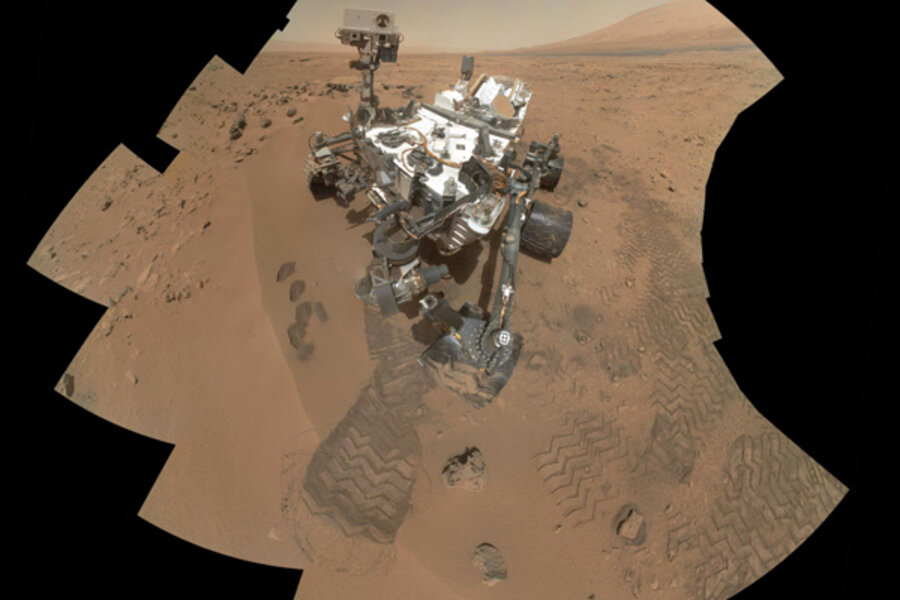Mars rover Curiosity soil analysis: why no news still isn't bad news
Loading...
NASA's Mars rover Curiosity has finished its first full-scale analysis of the surface soil in Gale Crater, and while researchers have yet to find definitive evidence pointing to organic compounds that would signal ancient habitats, they did find something else they were looking for: soils that look pretty much like soils other rovers and landers have analyzed elsewhere on the planet.
At first blush, spending $2.5 billion and traveling more than 350 million miles to find more of the same may seem like a bit of overkill. But training the full suite of Curiosity's instruments on something fairly well known during what is still the rover's shakedown period represents an important opening move in the rover's mission, researchers say.
During its two-year prime mission, the one-ton, Mini Cooper-sized lab on wheels aims to see if its new home – Gale Crater with its towering central peak, Mt. Sharp – once may have been hospitable to simple forms of life. Finding and analyzing any organic compounds in the mountain's ancient layers represents the ultimate prize in that quest.
The soil analysis establishes a relatively modern reference against which the chemical and mineral makeup of Mt. Sharp's far-more ancient land forms can be compared.
The soil results have yielded "an unprecedented look at the chemical diversity in the area that is representative of the rest of the planet," said Michael Meyer, the mission's program scientist, in a briefing at the annual fall meeting of the American Geophysical Union, currently underway in San Francisco.
The results "form a solid baseline for our continued exploration," he says.
During its six-week stay at a site named Rocknest, the rover sampled soils from a mini dune about 5 inches high dubbed Windrift. The rover scooped five samples in all. The initial samples were used to clean the interior of the sample-delivery system of any contaminants that hitched a ride from Earth. The fifth sample served as the fodder for the rover's internal chemistry labs.
Below the dune's surface the sands were fine-grained compared with the surface layer – somewhere between grains of sugar and flour in size. The large, salt-sized grains on the dune's surface, which included tiny glass nodules, were coated in the red dust characteristic of Mars, explains Ken Eddget, the lead scientist for a camera on the rover’s robotic arm that fills the role of a geologist's magnifying glass.
Water vapor, carbon dioxide, molecular oxygen, and sulfur dioxide were among the most prominent gases generated by the three instruments that comprise the rover's Sample Analysis at Mars (SAM) component, notes Paul Mahaffy, a researcher at NASA's Goddard Space Flight Center in Greenbelt, Md., and SAM's lead scientist.
But the SAM also detected some simple hydrocarbons made up of chlorine and methane. Does that mean Martian-based organics are in the bag? The team suspects not, although it is conducting a thorough analysis. Surface soils are exposed to a range of radiation and chemicals in the atmosphere that tend to dismantle organic compounds.
The researchers say they suspect that the chlorine came from perchlorates in the soil, perhaps calcium perchlorate, Dr. Mahaffy says. Perchlorates are chlorine-based salts. The Phoenix Mars lander found perchlorates in abundance at its polar landing site in 2008.
The carbon in the methane is another story, however. It could represent residual contamination from Earth, despite extensive efforts to scrub the rovers before launch. Or the carbon could have come from the soil. But carbon in soils could be organic as well as inorganic. Indeed, Mahaffy holds out the possibility that the simples forms of chloromethane SAM detected could have formed during the analysis process, with carbon dioxide freed from the soil samples as they were heated serving as the source of the carbon. If the carbon is organic, researchers still have to figure out if the carbon is indigenous to Mars, or hitched a ride to the surface on micrometeoroids.
Given the various ways organic compounds can be destroyed on the Martian surface, "it's really going to be an exciting hunt ... over the course of this mission to find early environments that might be kind of protected from this harsh surface environment and really see what we can add to the organics story," Mahaffy says.







